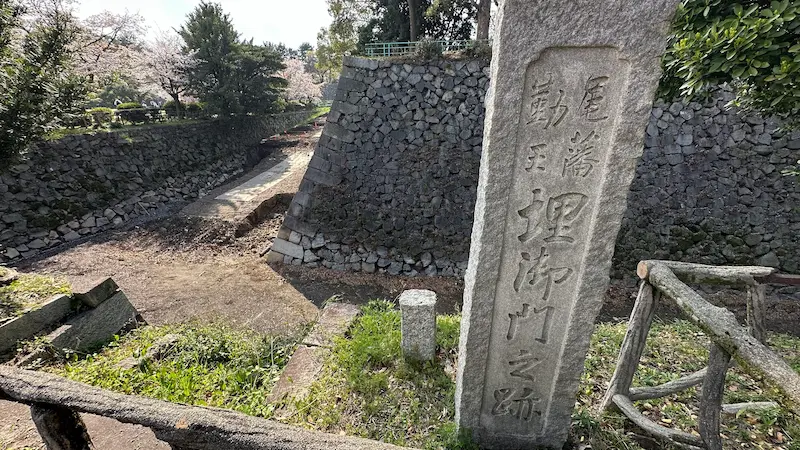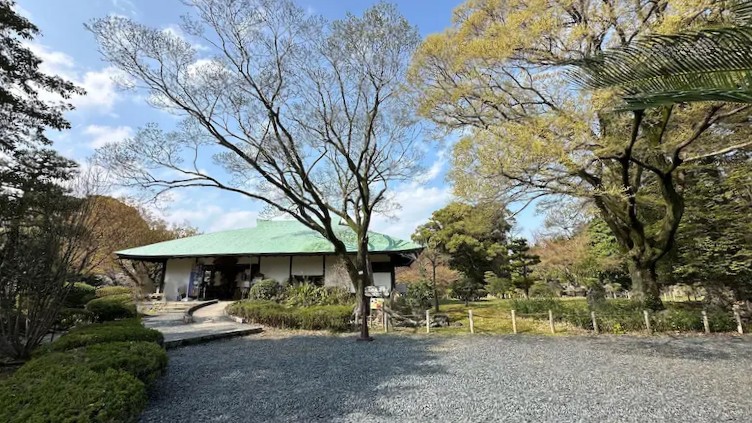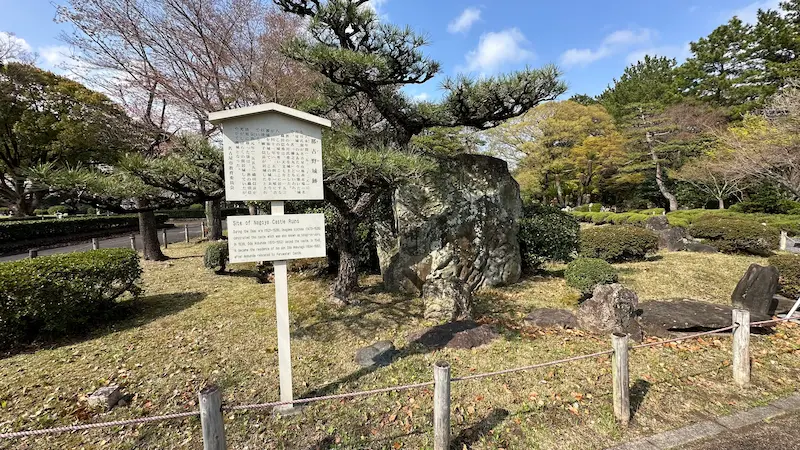Discover a Hidden Layer of History: A Special Walking Trail Through Nagoya Castle’s Secret Past
Tucked away in the Ninomaru Garden of Nagoya Castle are lesser-known yet deeply significant historical sites: the Uzumimon Remains (Hidden Gate), the Nagoya Castle Teahouse, and the Ruins of Nagono Castle, linked to Oda Nobunaga. Though they may not stand out at first glance, each of these locations offers a rich blend of heritage and traditional Japanese aesthetics. Perfect for both history enthusiasts and those seeking peaceful reflection, this trail reveals the quieter, more contemplative side of Nagoya Castle.
Uzumimon Remains (Hidden Gate)

🏛 Overview
The Uzumimon Remains are located in the northwestern part of Ninomaru Garden. This secret passage was designed as an emergency escape route for the castle lord during times of crisis. Constructed beneath stone walls and earthen barriers, it allowed covert passage out of the castle, away from the eyes of enemies.
After exiting the gate, one would descend a steep staircase, cross the moat, and reach the gardens of Fukai-maru. From there, a hidden path led through Ōzone, Kachigawa, and Jōkōji Temple, ultimately connecting to the Kiso Road—a strategic escape route in times of siege.
While the actual gate no longer exists, a commemorative stone monument marks its former location, offering a glimpse into the defensive ingenuity of Nagoya Castle.
🗺 Address:
1-1 Honmaru, Naka-ku, Nagoya, Aichi Prefecture, inside Ninomaru Garden
🚶 Access:
Approx. 1-minute walk (40m) from the Nanban Plaster Wall
⏳ Recommended Visit Duration:
- Quick Look: ~5 minutes
- In-Depth Exploration: ~10 minutes
📍 Highlights:
🔹 Uzumimon Monument: A stone marker commemorates the hidden gate, allowing visitors to reflect on its historical significance.
🔹 Ninomaru Garden: A designated scenic spot that offers picturesque seasonal views year-round.
🔹 Seasonal Experiences: Cherry blossoms in spring and colorful foliage in autumn create a stunning natural backdrop.
📌 Trivia:
- Historical Insight: Designed for the lord’s secret escape, the gate was built to avoid detection and ensure safety during emergencies.
- Hidden Detail: A favorite spot among history lovers, Uzumimon remains are a must-see for those seeking the lesser-known stories of Nagoya Castle.
- Famous Connections: Built under the command of Tokugawa Ieyasu, the gate was an integral part of the castle’s original design.
Ninomaru Teahouse (Chatei)

🏛 Overview
Located in a serene corner of Ninomaru Garden, the Ninomaru Teahouse offers visitors a tranquil place to relax while enjoying matcha green tea and traditional Japanese sweets. Surrounded by a strolling garden with ponds and seasonal foliage, this peaceful retreat blends seamlessly with the natural and historical setting of the castle grounds.
The teahouse has become a cherished resting place for visitors exploring the castle, offering a moment of calm within a setting rich in history and Japanese aesthetic values.
🗺 Address:
1-1 Honmaru, Naka-ku, Nagoya, Aichi Prefecture, inside Ninomaru Garden
🚶 Access:
Approx. 1-minute walk (110m) from the Uzumimon Remains
⏳ Recommended Visit Duration:
- Brief Stop: ~5 minutes
- Relaxed Break: ~30 minutes
📍 Highlights:
🔹 Enjoy Matcha at the Teahouse: Savor traditional tea and sweets while gazing at the surrounding garden, which transforms with each season.
🔹 Architectural Style: Built in the sukiya-zukuri style, the structure showcases the refined simplicity of traditional Japanese design.
🔹 Seasonal Experiences: Spring cherry blossoms, lush greenery in early summer, vibrant autumn leaves, and winter snowscapes each offer their own special ambiance.
📌 Trivia:
- Historical Insight: The current teahouse was reconstructed to reflect Edo-period architecture, in harmony with the garden’s traditional design.
- Hidden Detail: The sweets served change with the seasons, offering a different experience each time you visit.
- Famous Connections: In the Edo period, several teahouses were built in the garden to entertain feudal lords and guests—a tradition continued by this teahouse today.
Ruins of Nagono Castle

🏛 Overview
Located near the Ninomaru area of present-day Nagoya Castle, the Nagono Castle Ruins are a significant historical site dating back to the Muromachi and Sengoku periods. The castle is believed to have been constructed during the Eisho era (1504–1521) by Imagawa Ujitoyo, a member of the Imagawa clan. It was also known at the time as “Yanaginomaru.”
Later, the castle was seized by Oda Nobuhide, father of Oda Nobunaga, who lived there during his youth. Historical records suggest that Nobunaga resided here from the age of eight until his coming-of-age ceremony.
In 1552, Nobunaga relocated to Kiyosu Castle, marking the end of Nagono Castle’s role. Though the original castle was never rebuilt, its grounds were later incorporated into the Ninomaru section of Nagoya Castle.
Today, while no visible ruins remain, a memorial stone monument within Ninomaru Garden commemorates the former site of Nagono Castle.
🗺 Address:
1-1 Honmaru, Naka-ku, Nagoya, Aichi Prefecture, inside Ninomaru Garden
🚶 Access:
Approx. 1-minute walk (60m) from the Ninomaru Teahouse
⏳ Recommended Visit Duration:
- Quick Look: ~3 minutes
- Deeper Exploration: ~15 minutes
📍 Highlights:
🔹 Nagono Castle Monument: A commemorative stone within the garden marks the location of the historic castle.
🔹 Ninomaru Garden: Offers a scenic setting for walks and historical contemplation, enhanced by seasonal beauty.
🔹 Seasonal Experiences: In spring and autumn, the garden’s cherry blossoms and foliage create a vibrant contrast to the historical backdrop.
📌 Trivia:
- Historical Insight: Originally built by the Imagawa clan, the castle was taken over by the Oda family, and briefly served as Oda Nobunaga’s residence.
- Hidden Detail: Though ruins are no longer visible, the monument has become a symbolic site, cherished by history lovers.
- Famous Connections: Nagono Castle is closely tied to Oda Nobunaga, one of Japan’s most legendary warlords, marking an important chapter in Sengoku-era history.



comment